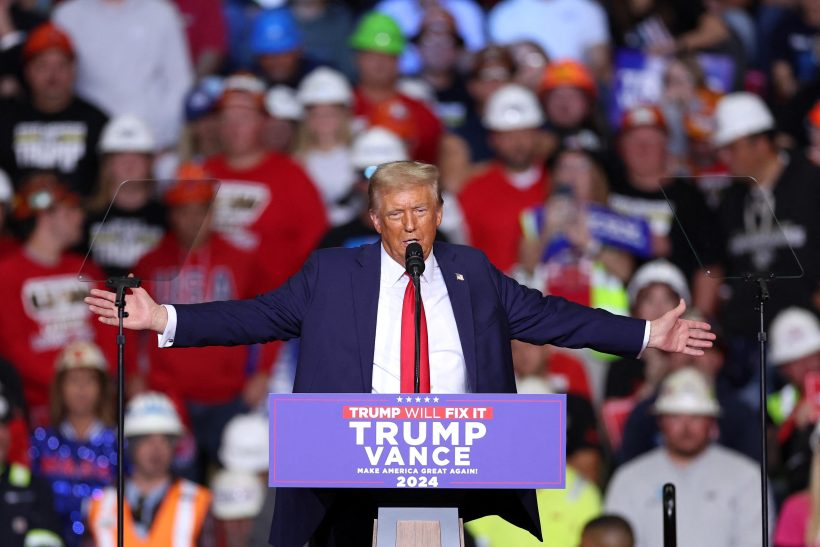Anticipating Trump’s Return: Implications for cryptocurrency Traders
With Donald trump poised to reclaim his position in the Oval Office, traders are increasingly curious about how his upcoming term might influence the cryptocurrency market.
The Potential Shift in Regulatory Landscape
Trump’s management is known for its distinct approach to regulation, notably regarding emerging technologies like cryptocurrencies. During his first term, there was a notable emphasis on deregulation, which many believe could resurface. This shift may lead to a more favorable environment for digital currencies as businesses seek clarity and support from goverment policies.
Market Reactions and Historical Context
Historically, critically important political events have had profound effects on financial markets. As a notable example, during Trump’s initial presidency proclamation in 2016, Bitcoin experienced substantial price fluctuations. As we look ahead to his second term, traders are keenly observing similar patterns that could indicate future movements within the crypto space.
the Role of Economic Policies
The economic strategies implemented by Trump will also play a crucial role in shaping investor sentiment towards cryptocurrencies.If he prioritizes tax cuts or stimulus measures aimed at boosting economic growth post-pandemic, it could lead to increased investment in alternative assets like Bitcoin and Ethereum as individuals seek hedges against inflation.
Global Perspectives and Comparisons
Around the world, countries are grappling with their own regulatory frameworks concerning digital currencies. For example, nations such as El Salvador have embraced Bitcoin as legal tender while others remain cautious or outright prohibitive. Observing thes international trends can provide valuable insights into how Trump’s policies might align or contrast with global attitudes toward cryptocurrency adoption.
Conclusion: A New Era for Crypto?
The intersection of politics and finance is always complex; however, Trump’s return may usher in new dynamics within the cryptocurrency sector. As traders prepare for potential changes ahead, staying informed about both domestic policies and global developments will be essential for navigating this evolving landscape effectively.
trump’s Administration: A Complex Relationship with Digital Currencies
the tenure of Donald Trump was characterized by a blend of skepticism and criticism towards cryptocurrencies, often viewing them as a potential danger to the supremacy of the US dollar. However,the policies and political decisions made during his presidency inadvertently influenced the cryptocurrency landscape in various ways.
Anticipating the Impact of Trump’s Inauguration on Cryptocurrency Trading
As we approach the possibility of Donald Trump’s return to office, analysts are beginning to speculate on the implications this may have for various sectors, particularly cryptocurrency. This article aims to explore what crypto investors might anticipate following his swearing-in ceremony.
The Political Landscape and Its Influence on Crypto markets
The political environment plays a crucial role in shaping market dynamics. With Trump’s previous presidency marked by significant fluctuations in cryptocurrency values, traders are keenly observing how his policies could affect digital currencies this time around. For instance, during his first term, Bitcoin experienced notable surges and declines that were often correlated with political events and announcements.
potential Regulatory Changes Under Trump
One area of interest is regulatory frameworks surrounding cryptocurrencies. Experts predict that if Trump returns to power, there may be shifts towards more lenient regulations aimed at fostering innovation within the blockchain space. This could potentially lead to increased investment from institutional players who have been hesitant due to stringent compliance requirements.
Market Reactions: Historical Context
A look back at past market reactions can provide insights into future trends. For example, after Trump’s election victory in 2016, Bitcoin’s value surged as investors sought alternative assets amidst uncertainty in traditional markets. similarly,any favorable policy announcements regarding cryptocurrencies could trigger positive sentiment among traders once again.
The Role of Public Sentiment and Media Coverage
The media’s portrayal of Trump’s administration will also significantly impact public sentiment towards cryptocurrencies. Positive coverage highlighting advancements or supportive legislation could bolster confidence among investors while negative narratives might induce caution or volatility within the market.
Current Trends: A Snapshot of Today’s Crypto Market
As we stand today, the cryptocurrency landscape is evolving rapidly with new technologies emerging daily. According to recent statistics from industry reports, global crypto adoption has surged by over 200% as last year alone—an indicator that regardless of political changes ahead, interest in digital currencies continues unabated.
Conclusion: Preparing for Uncertainty Ahead
Certainly, uncertainty looms as we await potential changes post-inauguration; however, savvy traders can prepare by staying informed about both political developments and market trends. By understanding historical patterns and anticipating regulatory shifts under a new administration led by Trump, crypto enthusiasts can better navigate this volatile yet promising landscape.
Trump’s Perspective on Cryptocurrency: A Historical overview
Former President Donald Trump has had a fluctuating relationship with cryptocurrency,marked by strong opinions and notable statements. His views have evolved over time, reflecting broader trends in the financial landscape and the growing prominence of digital currencies.
The Initial Skepticism
In 2019, Trump publicly expressed his skepticism towards Bitcoin and other cryptocurrencies.He labeled them as “a scam” that could potentially undermine the U.S. dollar’s status as the world’s primary reserve currency. This stance resonated with traditional financial institutions that were wary of decentralized currencies disrupting established economic systems.
Regulatory Concerns
Trump’s administration took a cautious approach to cryptocurrency regulation. The focus was primarily on consumer protection and preventing illicit activities associated with digital assets. During his presidency, discussions around regulatory frameworks intensified, highlighting concerns about fraud and market volatility.
A Shift in Tone
Despite his earlier criticisms, Trump’s tone regarding cryptocurrencies began to shift as he recognized their growing popularity among investors and tech enthusiasts. By 2021, he acknowledged that while he remained skeptical about Bitcoin specifically, he saw potential in blockchain technology itself—a crucial component of many cryptocurrencies.
The Rise of Digital Assets
The surge in interest surrounding cryptocurrencies during this period cannot be overlooked; for instance,Bitcoin reached an all-time high near $64,000 in April 2021. This dramatic increase drew attention from both retail investors and institutional players alike.
Current Trends Under Biden Administration
With Joe Biden now at the helm, discussions around cryptocurrency have continued to evolve rapidly. The current administration is exploring extensive regulations aimed at fostering innovation while ensuring consumer safety—an approach that contrasts sharply with Trump’s more hands-off perspective during his tenure.
Conclusion: A Complex Legacy
Donald Trump’s legacy regarding cryptocurrency is complex; it reflects both caution against potential risks and an acknowledgment of its transformative potential within modern finance.As digital currencies continue to gain traction globally—evidenced by recent statistics showing over 300 million crypto users worldwide—the dialog surrounding their regulation will remain critical for policymakers moving forward.
Trump’s Stance on Cryptocurrency: A Critical Perspective
Former President Donald Trump has consistently expressed doubts regarding the legitimacy of cryptocurrencies. In a notable tweet from 2019, he stated, “I do not support Bitcoin and other cryptocurrencies, as they do not qualify as real currency and their value fluctuates unpredictably.” This skepticism highlights his concerns about the stability and reliability of digital currencies.
Regulatory Shifts in the Cryptocurrency Landscape
The growing sentiment surrounding cryptocurrencies has led to the implementation of stricter regulations aimed at enhancing oversight within the digital asset sector. Interestingly, historical patterns indicate that Bitcoin and various other cryptocurrencies tend to experience price surges during periods of political unrest, exemplified by the fluctuations observed during Donald Trump’s initial inauguration.
Market Reactions to Political events: the Case of Bitcoin
During that period, the value of Bitcoin witnessed significant increases as many investors regarded it as a safeguard against uncertainties in both the economy and political landscape. This perspective invites an examination of how Trump’s potential re-election could impact financial markets, presenting both risks and opportunities for investors and developers alike.
Balancing Act: The Tension Between Regulation and Innovation
In today’s rapidly evolving technological landscape, the debate surrounding regulation versus innovation has become increasingly prominent. As industries strive to push boundaries and develop groundbreaking solutions, the question arises: how much oversight is necessary to ensure safety and ethical standards without stifling creativity?
The Need for Oversight
Regulatory frameworks are essential in safeguarding public interests. They establish guidelines that protect consumers from potential harm while ensuring fair competition among businesses. For instance, in the realm of data privacy, regulations like the General Data Protection Regulation (GDPR) have set a benchmark for how companies handle personal facts. This not only empowers individuals but also fosters trust in digital platforms.
Innovation at Risk
On the flip side,excessive regulation can hinder progress. Startups and tech innovators often face significant barriers when navigating complex legal landscapes.A recent study indicated that nearly 60% of entrepreneurs believe regulatory challenges impede their ability to launch new products effectively.This sentiment highlights a critical dilemma: how can we maintain necessary safeguards without obstructing innovation?
Striking a Balance
The key lies in finding an equilibrium between these two forces. Policymakers must engage with industry leaders to create adaptive regulations that evolve alongside technological advancements. For example, rather than imposing blanket rules on emerging technologies like artificial intelligence or blockchain, tailored approaches could be developed that address specific risks while allowing room for growth.
A Collaborative Approach
Collaboration between regulators and innovators is crucial for fostering an environment conducive to both safety and creativity. Initiatives such as regulatory sandboxes allow companies to test new ideas within a controlled setting before full-scale implementation—an approach successfully adopted by several countries worldwide.
The Future Landscape
As we look ahead, it’s clear that both regulation and innovation will play pivotal roles in shaping our future economy. By embracing flexible policies that encourage experimentation while prioritizing consumer protection, we can cultivate an ecosystem where groundbreaking ideas flourish alongside robust safeguards.
This ongoing dialogue between regulation and innovation will ultimately determine not just the trajectory of individual industries but also the broader implications for society as a whole.
potential Implications of a Second Trump Administration on Cryptocurrency Regulations
The prospect of Donald Trump returning to the presidency could reignite debates surrounding cryptocurrency legislation. During his previous term, his administration implemented stricter regulations that emphasized enhanced No Your Customer (KYC) protocols and Anti-Money Laundering (AML) measures. While these regulations may pose immediate hurdles for decentralized platforms,they also have the potential to foster long-term stability by eliminating fraudulent schemes and rebuilding confidence among investors.
The Influence of economic Policies on Cryptocurrency Adoption
Moreover, the approach taken by Trump to strengthen the US dollar may have a significant effect on the adoption of cryptocurrencies. Should his administration prioritize avoiding the devaluation of the dollar due to extensive fiscal policies or international trade conflicts, it could lead investors to seek safety in Bitcoin and various other digital currencies. This phenomenon was notably observed during the economic instability experienced in his initial term, where Bitcoin gained recognition as a form of “digital gold.”
Understanding Market Responses: Anticipations and Insights
In the ever-evolving landscape of finance, market reactions can often be unpredictable.Investors and analysts alike strive to decipher patterns that may indicate future movements. This article delves into what one might anticipate in terms of market behavior, especially during pivotal economic events.
Factors Influencing Market Dynamics
The financial markets are influenced by a myriad of factors ranging from economic indicators to geopolitical developments. As an example, recent data from the Bureau of Economic Analysis shows that consumer spending has risen by 4% over the last quarter, suggesting a robust economy which could lead to bullish trends in stock prices.
Moreover, interest rates play a crucial role in shaping investor sentiment. As central banks adjust rates to combat inflation or stimulate growth, these changes can trigger significant shifts in market dynamics. A recent increase in interest rates by the Federal Reserve has led many investors to reassess their portfolios and strategies.
Anticipating Volatility
Market volatility is an inherent characteristic that investors must navigate carefully. Historical trends indicate that periods of uncertainty frequently enough precede major price adjustments. For example,during the onset of global crises such as pandemics or political unrest,markets typically experience heightened fluctuations as traders react swiftly to new information.
A current illustration can be seen with ongoing tensions between major economies which have resulted in erratic trading patterns across various sectors including technology and energy stocks.
Strategies for Navigating Market Changes
To effectively manage investments amid fluctuating conditions, it is essential for investors to adopt strategic approaches tailored to their risk tolerance levels. Diversification remains a key strategy; spreading investments across different asset classes can mitigate risks associated with sudden market downturns.
Additionally, staying informed about macroeconomic trends and utilizing analytical tools can empower investors with insights necessary for making informed decisions during turbulent times.
The Role of Technology in Market Analysis
The integration of technology into financial analysis has transformed how traders interpret data and make decisions. advanced algorithms and machine learning models now assist analysts in predicting potential market movements based on historical data patterns combined with real-time news updates.
This technological advancement not only enhances accuracy but also allows for quicker responses to emerging situations—an invaluable asset when navigating volatile markets.
Conclusion: Preparing for Future Trends
As we look ahead at potential shifts within financial markets, understanding underlying factors driving these changes will be crucial for both seasoned investors and newcomers alike. By remaining vigilant about economic indicators while employing sound investment strategies bolstered by technological tools, individuals can better position themselves against unforeseen challenges ahead.
Economic Uncertainty Fuels Interest in Alternative Investments
Changes in the political landscape frequently enough lead to heightened economic concerns, prompting investors to explore alternative assets like Bitcoin. A notable instance occurred during the 2020 United States presidential election, when Bitcoin surged over 30% within a single month, highlighting its growing role as a safeguard against financial volatility.
The Impact of Regulatory Changes on Cryptocurrency Exchanges
As regulatory frameworks evolve, cryptocurrency exchanges and platforms may face heightened examination. with the Trump administration’s push for stricter regulations, smaller, unregulated projects could encounter significant financial challenges. In contrast, larger firms may benefit from clearer guidelines that enhance their operational stability and market position.Navigating a New Regulatory Landscape
The shifting regulatory environment presents both risks and opportunities within the crypto space. Smaller entities that lack robust compliance measures might struggle to adapt to new requirements, potentially jeopardizing their financial viability. Conversely, established companies with resources to navigate these changes could emerge stronger as they align with regulatory expectations.Conclusion: A Dual-Edged Sword
while increased scrutiny can pose challenges for smaller projects in the cryptocurrency sector, it also paves the way for larger organizations to solidify their standing in a more regulated marketplace.As this landscape continues to develop, stakeholders must remain vigilant and adaptable to thrive amidst these changes.Final Thoughts
the journey towards achieving your goals is often filled with challenges and opportunities for growth. Embracing a positive mindset can significantly influence your ability to overcome obstacles and reach new heights.
As you navigate through various experiences, remember that resilience plays a crucial role in your success.Studies indicate that individuals who cultivate resilience are more likely to adapt to change and thrive in difficult situations. As an example, recent research from the American Psychological Association highlights that resilient people tend to maintain better mental health during stressful times.
Moreover,setting clear objectives is essential for maintaining focus and motivation. By breaking down larger aspirations into manageable tasks, you can create a roadmap that guides you toward your desired outcomes. This approach not only enhances productivity but also fosters a sense of accomplishment as you complete each step along the way.
Additionally,surrounding yourself with supportive individuals can amplify your efforts. Engaging with mentors or peers who share similar ambitions can provide valuable insights and encouragement throughout your journey.
Ultimately, success is not merely defined by reaching specific milestones but also by the lessons learned along the way. Each experience contributes to personal development and equips you with skills necessary for future endeavors.
As we conclude this discussion on goal achievement, let us remember that persistence combined with adaptability will pave the path toward fulfilling our dreams.
Anticipating Changes in the Crypto Landscape Post-Trump Inauguration
The upcoming inauguration of Trump is poised to introduce stricter regulations that could significantly impact cryptocurrency innovation and its widespread acceptance. While there have been instances in the past where trump’s policies have created turbulence within the crypto sector, it’s essential to maintain an optimistic outlook.
Historical Context of Regulatory Impact
Historically, regulatory measures can either stifle or stimulate growth within emerging markets. Trump’s previous administration saw a series of policy shifts that affected digital currencies, leading to uncertainty among investors and developers alike. Though, these challenges also prompted the industry to adapt and innovate in response.
A New Era for cryptocurrency?
The potential for a rebalancing effect on the cryptocurrency market under Trump’s leadership could lead to more defined frameworks that promote stability. As regulations become clearer,businesses may find it easier to navigate compliance requirements while fostering innovation.
Looking Ahead: Opportunities Amidst Challenges
Despite concerns over increased oversight, this new regulatory environment might encourage legitimate players in the crypto space to emerge stronger. For instance, companies focusing on clarity and security may gain a competitive edge as consumers seek trustworthy platforms amidst evolving regulations.
The Importance of Adaptation
The ability of cryptocurrency firms to pivot and adapt will be crucial during this transitional phase. By embracing compliance measures proactively rather than reactively, these organizations can position themselves favorably for future growth opportunities.
Conclusion: A Balanced Perspective
While tighter controls may initially seem daunting for crypto enthusiasts and investors alike, they also present an possibility for maturation within the industry. By fostering a culture of compliance alongside innovation,we can look forward to a more robust future for cryptocurrencies as they continue their journey into mainstream acceptance.







